Alfa Romeo 156 2006 Owner handbook (in English)
Manufacturer: ALFA ROMEO, Model Year: 2006, Model line: 156, Model: Alfa Romeo 156 2006Pages: 357, PDF Size: 5.04 MB
Page 51 of 357
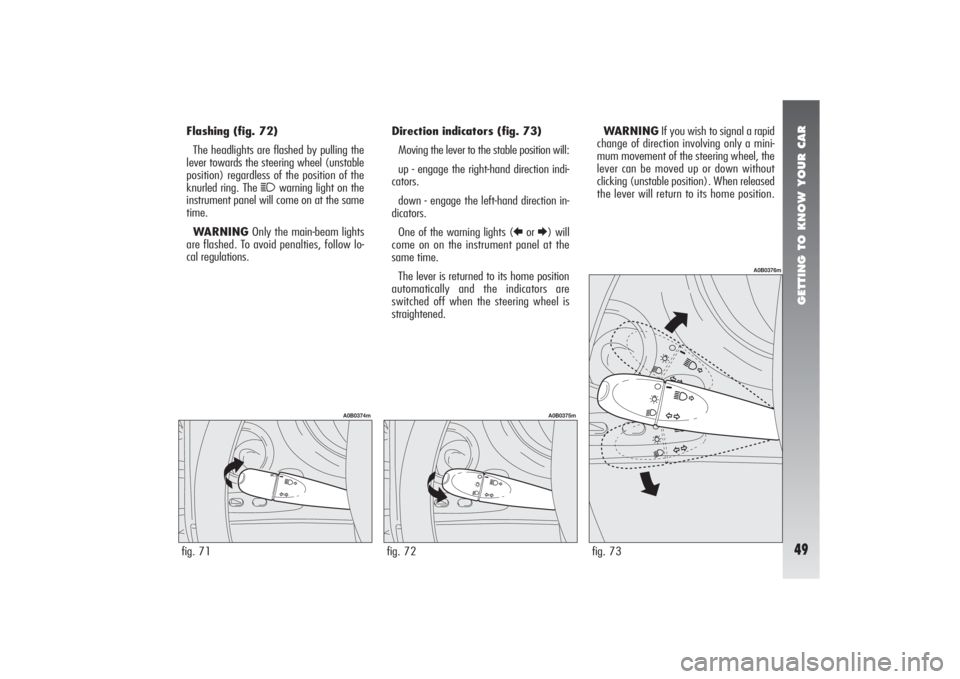
GETTING TO KNOW YOUR CAR49
Flashing (fig. 72)
The headlights are flashed by pulling the
lever towards the steering wheel (unstable
position) regardless of the position of the
knurled ring. The
1
warning light on the
instrument panel will come on at the same
time.
WARNINGOnly the main-beam lights
are flashed. To avoid penalties, follow lo-
cal regulations.Direction indicators (fig. 73)
Moving the lever to the stable position will:
up - engage the right-hand direction indi-
cators.
down - engage the left-hand direction in-
dicators.
One of the warning lights (
R
or
E) will
come on on the instrument panel at the
same time.
The lever is returned to its home position
automatically and the indicators are
switched off when the steering wheel is
straightened.WARNINGIf you wish to signal a rapid
change of direction involving only a mini-
mum movement of the steering wheel, the
lever can be moved up or down without
clicking (unstable position). When released
the lever will return to its home position.
fig. 73
A0B0376m
fig. 71
A0B0374m
fig. 72
A0B0375m
Page 52 of 357

GETTING TO KNOW YOUR CAR50
RIGHT-HAND LEVERThe right-hand lever is used to operate the
windscreen wiper and windscreen washer.
The control used to activate the windscreen
washers also activates the headlights wash-
ers, if fitted.Windscreen wiper - windscreen
washer (fig. 74-75)
The lever can be moved to five different
positions corresponding to:
A- Stationary (off).
B- Intermittent.
With the lever in position (B), turning the
ring (F) four possible intermittent speeds
are obtained:
■
= intermittent slow.
■■
= intermittent medium.
■■■
= intermittent medium-fast.
■■■■
= intermittent fast.C- Continuous, slow.
D- Continuous, fast.
E- Fast, temporary (unstable position).
Operation in position (E) is limited to the
time the lever is held in this position. When
the lever is released, it returns to position
(A) automatically stopping the wiper.
fig. 75
A0B0377m
fig. 74
A0B0250m
Page 53 of 357
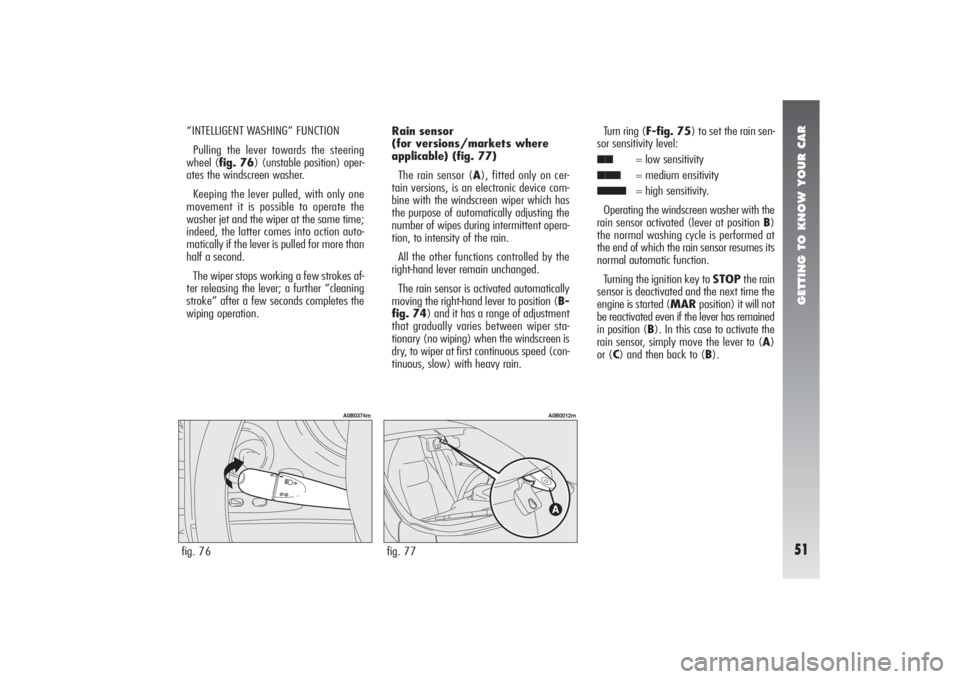
GETTING TO KNOW YOUR CAR51
“INTELLIGENT WASHING” FUNCTION
Pulling the lever towards the steering
wheel (fig. 76) (unstable position) oper-
ates the windscreen washer.
Keeping the lever pulled, with only one
movement it is possible to operate the
washer jet and the wiper at the same time;
indeed, the latter comes into action auto-
matically if the lever is pulled for more than
half a second.
The wiper stops working a few strokes af-
ter releasing the lever; a further “cleaning
stroke” after a few seconds completes the
wiping operation.Rain sensor
(for versions/markets where
applicable) (fig. 77)
The rain sensor (A), fitted only on cer-
tain versions, is an electronic device com-
bine with the windscreen wiper which has
the purpose of automatically adjusting the
number of wipes during intermittent opera-
tion, to intensity of the rain.
All the other functions controlled by the
right-hand lever remain unchanged.
The rain sensor is activated automatically
moving the right-hand lever to position (B-
fig. 74) and it has a range of adjustment
that gradually varies between wiper sta-
tionary (no wiping) when the windscreen is
dry, to wiper at first continuous speed (con-
tinuous, slow) with heavy rain.Turn ring (F-fig. 75) to set the rain sen-
sor sensitivity level:
■■
= low sensitivity
■■■
= medium ensitivity
■■■■
= high sensitivity.
Operating the windscreen washer with the
rain sensor activated (lever at position B)
the normal washing cycle is performed at
the end of which the rain sensor resumes its
normal automatic function.
Turning the ignition key to STOPthe rain
sensor is deactivated and the next time the
engine is started (MAR position) it will not
be reactivated even if the lever has remained
in position (B). In this case to activate the
rain sensor, simply move the lever to (A)
or (C) and then back to (B).
fig. 76
A0B0374m
fig. 77
A0B0012m
Page 54 of 357
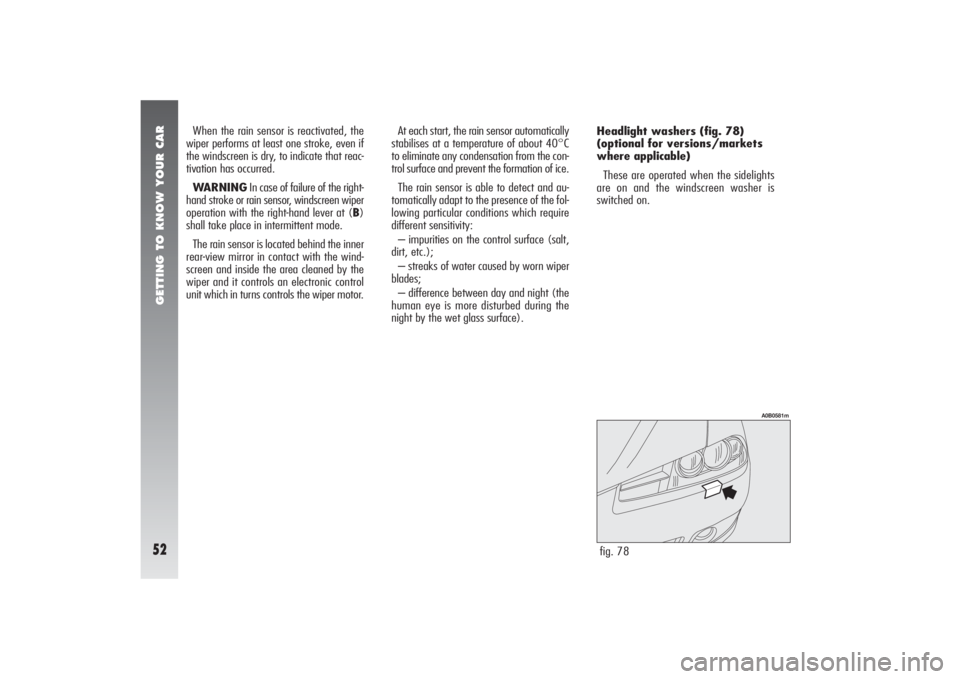
GETTING TO KNOW YOUR CAR52
When the rain sensor is reactivated, the
wiper performs at least one stroke, even if
the windscreen is dry, to indicate that reac-
tivation has occurred.
WARNINGIn case of failure of the right-
hand stroke or rain sensor, windscreen wiper
operation with the right-hand lever at (B)
shall take place in intermittent mode.
The rain sensor is located behind the inner
rear-view mirror in contact with the wind-
screen and inside the area cleaned by the
wiper and it controls an electronic control
unit which in turns controls the wiper motor.At each start, the rain sensor automatically
stabilises at a temperature of about 40°C
to eliminate any condensation from the con-
trol surface and prevent the formation of ice.
The rain sensor is able to detect and au-
tomatically adapt to the presence of the fol-
lowing particular conditions which require
different sensitivity:
– impurities on the control surface (salt,
dirt, etc.);
– streaks of water caused by worn wiper
blades;
– difference between day and night (the
human eye is more disturbed during the
night by the wet glass surface).Headlight washers (fig. 78)
(optional for versions/markets
where applicable)
These are operated when the sidelights
are on and the windscreen washer is
switched on.
fig. 78
A0B0581m
Page 55 of 357
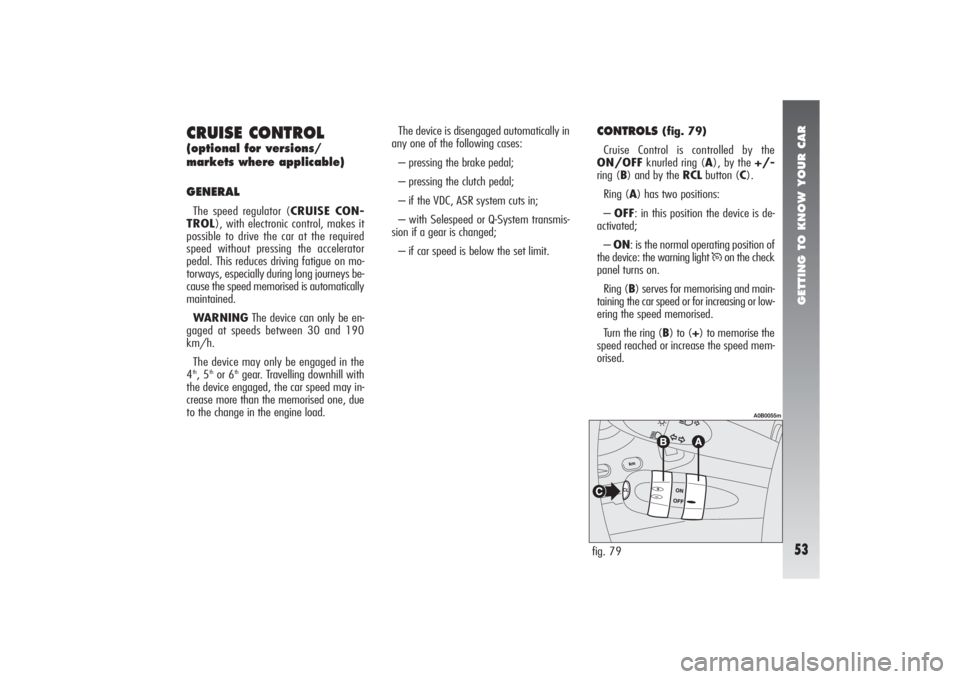
GETTING TO KNOW YOUR CAR53
CRUISE CONTROL(optional for versions/
markets where applicable)
GENERALThe speed regulator (CRUISE CON-
TROL), with electronic control, makes it
possible to drive the car at the required
speed without pressing the accelerator
pedal. This reduces driving fatigue on mo-
torways, especially during long journeys be-
cause the speed memorised is automatically
maintained.
WARNINGThe device can only be en-
gaged at speeds between 30 and 190
km/h.
The device may only be engaged in the
4th, 5
thor 6
thgear. Travelling downhill with
the device engaged, the car speed may in-
crease more than the memorised one, due
to the change in the engine load.The device is disengaged automatically in
any one of the following cases:
– pressing the brake pedal;
– pressing the clutch pedal;
– if the VDC, ASR system cuts in;
– with Selespeed or Q-System transmis-
sion if a gear is changed;
– if car speed is below the set limit.
CONTROLS
(fig. 79)
Cruise Control is controlled by the
ON/OFFknurled ring (A), by the +/-
ring (B) and by the RCLbutton (C).
Ring (A) has two positions:
– OFF: in this position the device is de-
activated;
– ON: is the normal operating position of
the device: the warning light
Ü
on the check
panel turns on.
Ring (B) serves for memorising and main-
taining the car speed or for increasing or low-
ering the speed memorised.
Turn the ring (B) to (+) to memorise the
speed reached or increase the speed mem-
orised.
fig. 79
A0B0055m
Page 56 of 357
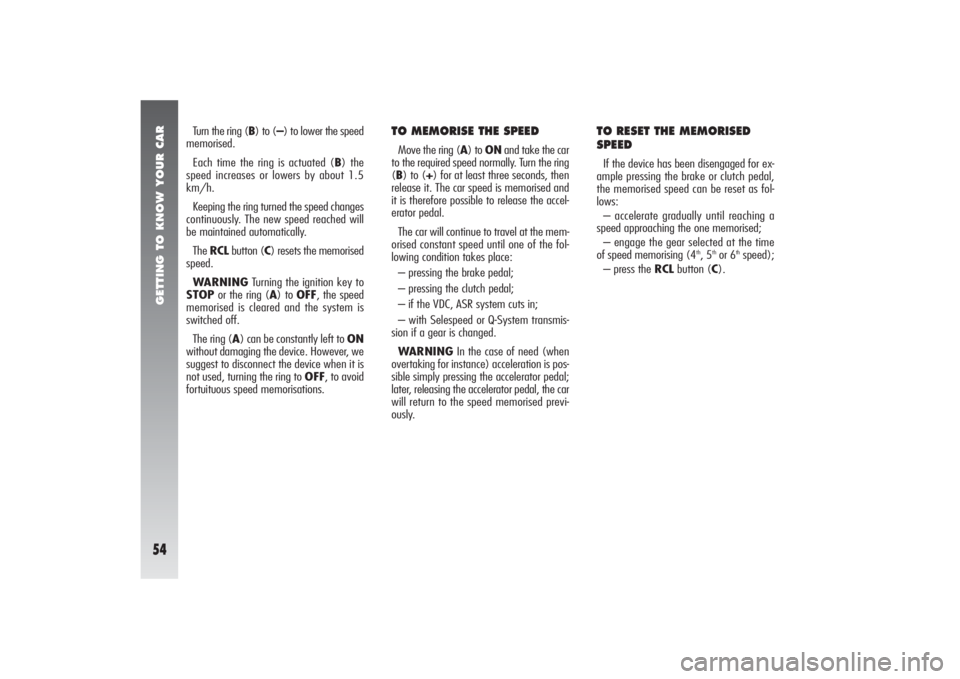
GETTING TO KNOW YOUR CAR54
Turn the ring (B) to (–) to lower the speed
memorised.
Each time the ring is actuated (B) the
speed increases or lowers by about 1.5
km/h.
Keeping the ring turned the speed changes
continuously. The new speed reached will
be maintained automatically.
The RCLbutton (C) resets the memorised
speed.
WARNINGTurning the ignition key to
STOPor the ring (A) to OFF, the speed
memorised is cleared and the system is
switched off.
The ring (A) can be constantly left to ON
without damaging the device. However, we
suggest to disconnect the device when it is
not used, turning the ring to OFF, to avoid
fortuituous speed memorisations.
TO MEMORISE THE SPEEDMove the ring (A) to ONand take the car
to the required speed normally. Turn the ring
(B) to (+) for at least three seconds, then
release it. The car speed is memorised and
it is therefore possible to release the accel-
erator pedal.
The car will continue to travel at the mem-
orised constant speed until one of the fol-
lowing condition takes place:
– pressing the brake pedal;
– pressing the clutch pedal;
– if the VDC, ASR system cuts in;
– with Selespeed or Q-System transmis-
sion if a gear is changed.
WARNINGIn the case of need (when
overtaking for instance) acceleration is pos-
sible simply pressing the accelerator pedal;
later, releasing the accelerator pedal, the car
will return to the speed memorised previ-
ously.
TO RESET THE MEMORISED
SPEEDIf the device has been disengaged for ex-
ample pressing the brake or clutch pedal,
the memorised speed can be reset as fol-
lows:
– accelerate gradually until reaching a
speed approaching the one memorised;
– engage the gear selected at the time
of speed memorising (4
th, 5
thor 6
thspeed);
– press the RCLbutton (C).
Page 57 of 357
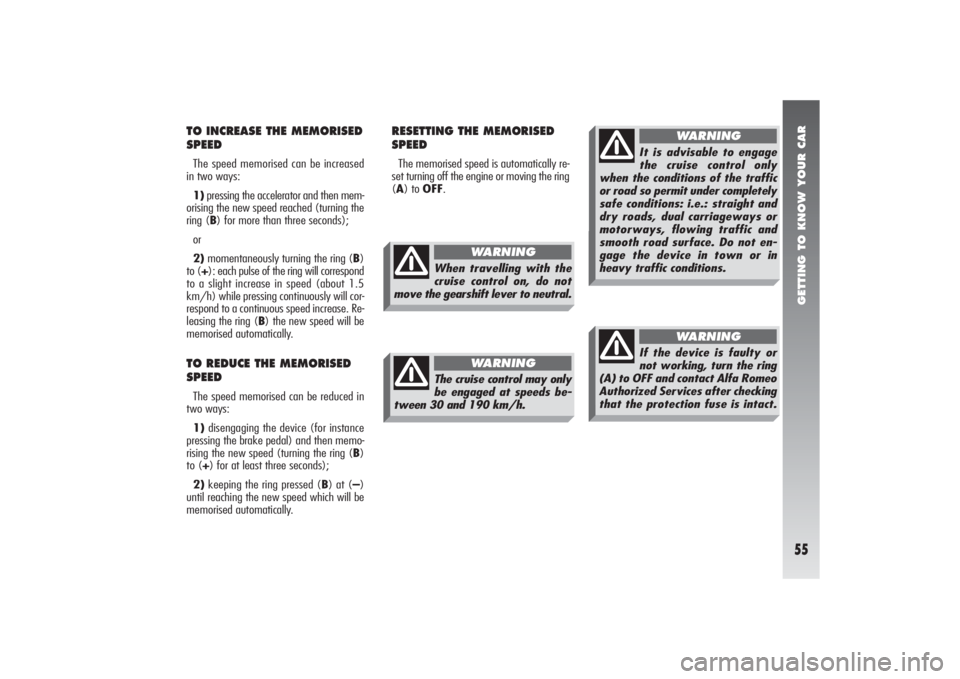
GETTING TO KNOW YOUR CAR55
TO INCREASE THE MEMORISED
SPEEDThe speed memorised can be increased
in two ways:
1)pressing the accelerator and then mem-
orising the new speed reached (turning the
ring (B) for more than three seconds);
or
2)momentaneously turning the ring (B)
to (+): each pulse of the ring will correspond
to a slight increase in speed (about 1.5
km/h) while pressing continuously will cor-
respond to a continuous speed increase. Re-
leasing the ring (B) the new speed will be
memorised automatically.TO REDUCE THE MEMORISED
SPEEDThe speed memorised can be reduced in
two ways:
1)disengaging the device (for instance
pressing the brake pedal) and then memo-
rising the new speed (turning the ring (B)
to (+) for at least three seconds);
2)keeping the ring pressed (B) at (–)
until reaching the new speed which will be
memorised automatically.
RESETTING THE MEMORISED
SPEEDThe memorised speed is automatically re-
set turning off the engine or moving the ring
(A) to OFF.
When travelling with the
cruise control on, do not
move the gearshift lever to neutral.
WARNING
The cruise control may only
be engaged at speeds be-
tween 30 and 190 km/h.
WARNING
It is advisable to engage
the cruise control only
when the conditions of the traffic
or road so permit under completely
safe conditions: i.e.: straight and
dry roads, dual carriageways or
motorways, flowing traffic and
smooth road surface. Do not en-
gage the device in town or in
heavy traffic conditions.
WARNING
If the device is faulty or
not working, turn the ring
(A) to OFF and contact Alfa Romeo
Authorized Services after checking
that the protection fuse is intact.
WARNING
Page 58 of 357
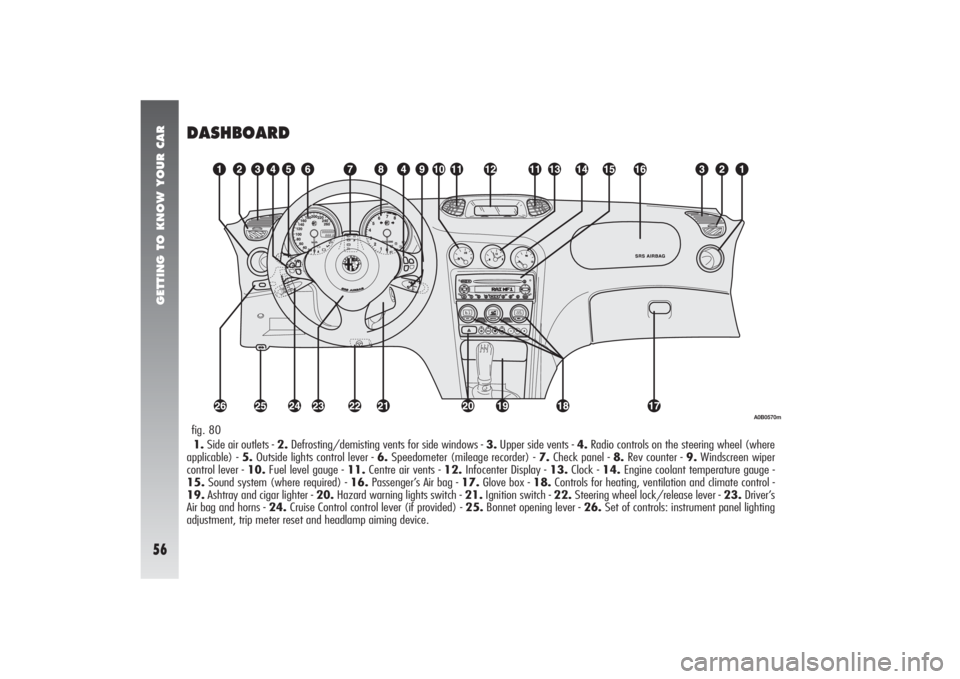
GETTING TO KNOW YOUR CAR56
DASHBOARD1.Side air outlets - 2.Defrosting/demisting vents for side windows - 3.Upper side vents - 4.Radio controls on the steering wheel (where
applicable) - 5.Outside lights control lever - 6.Speedometer (mileage recorder) - 7.Check panel - 8.Rev counter - 9.Windscreen wiper
control lever - 10.Fuel level gauge - 11.Centre air vents - 12.Infocenter Display - 13.Clock - 14.Engine coolant temperature gauge -
15.Sound system (where required) - 16.Passenger’s Air bag - 17.Glove box - 18.Controls for heating, ventilation and climate control -
19.Ashtray and cigar lighter - 20.Hazard warning lights switch - 21.Ignition switch - 22.Steering wheel lock/release lever - 23.Driver’s
Air bag and horns - 24.Cruise Control control lever (if provided) - 25.Bonnet opening lever - 26.Set of controls: instrument panel lighting
adjustment, trip meter reset and headlamp aiming device.fig. 80
A0B0570m
Page 59 of 357
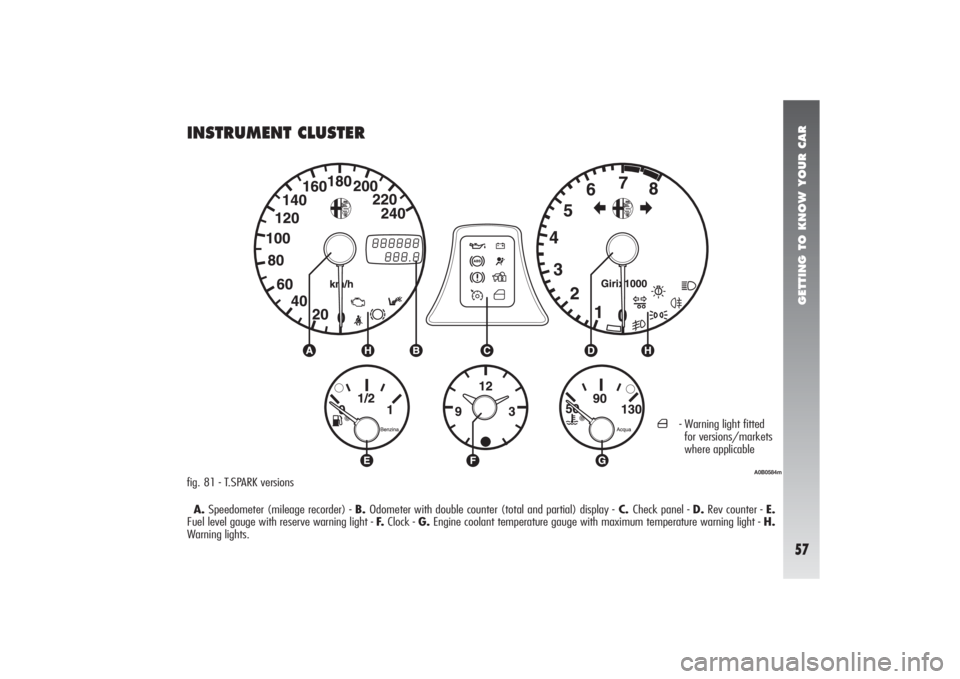
GETTING TO KNOW YOUR CAR57
INSTRUMENT CLUSTERfig. 81 - T.SPARK versions
A.Speedometer (mileage recorder) - B. Odometer with double counter (total and partial) display -C. Check panel - D.Rev counter - E.
Fuel level gauge with reserve warning light - F.Clock - G.Engine coolant temperature gauge with maximum temperature warning light - H.
Warning lights.
A0B0584m
´
- Warning light fitted
for versions/markets
where applicable
Page 60 of 357
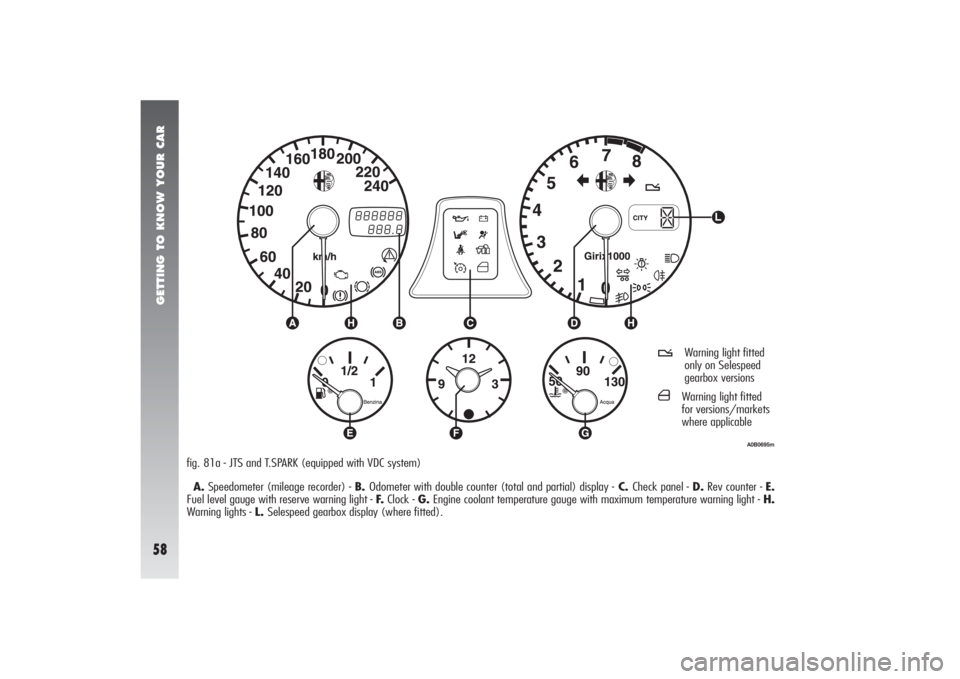
GETTING TO KNOW YOUR CAR58
A0B0695m
fig. 81a - JTS and T.SPARK (equipped with VDC system)
A.Speedometer (mileage recorder) - B. Odometer with double counter (total and partial) display -C. Check panel - D.Rev counter - E.
Fuel level gauge with reserve warning light - F.Clock - G.Engine coolant temperature gauge with maximum temperature warning light - H.
Warning lights - L. Selespeed gearbox display (where fitted).
t
Warning light fitted
only on Selespeed
gearbox versions
´
Warning light fitted
for versions/markets
where applicable